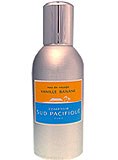
A few years back, CSP revamped their line with new packaging, new scents, and some reformulations. Mora Bella was one of the victims; it had been known as Fruits Sauvages, and savage it was, too.
The new version isn't drastically altered, though. I've smelled them side by side--I never owned the original, but I had a bunch of pochettes, those little packets containing a towelette soaked in scent, which CSP used to give out by the handful--and there are some differences: the original was brighter, sharper, more jagged, where the remake is more restrained and softer around the edges.
"Fruits Sauvages" means "wild fruit" in French, and fruit is the whole point of Mora Bella. If a scent
can be said to have a colour, then Mora Bella is dark, dark red, almost maroon. It starts with a giddy whirl of citrus notes, lemon and bergamot, and then barreling up from underneath them comes a volcano of fruit; pomegranate, raspberry, and blackberry. It is intense and it is very, very red.
The floralcy of the scent comes from jasmine and Marvel of Peru, a flower also known as the four o'clock because that's when it opens to release its perfume. These notes aren't enough to make the scent floral, or, god forbid, fruity-floral, but they do two things: they enrich the scent, making it less linear, but they also take some of the signature sharpness away from the fruit notes, which start out fresh and later take on a warmer, almost cooked aspect.
Like a great many CSP scents, Mora Bella doesn't last particularly long; a couple of hours in, and the floral notes are gone, the fruit notes are attenuated (cooked and eaten, I guess), and most of what remains is a very soft, musky wood scent that lies very close to the skin. Mora Bella is somewhat less unisex than its predecessor, though I still wear it with pleasure.
+
Regarding my discussion of
Baldessarini Ambré a while back, reader Steamy Vicks had this to say:
Good interpretation of this promising, but ultimately boring scent. However, I do think you have amber and ambergris confused.I'm not really confused about them, or at least not any more than the perfumery industry would have me be. I tend to use the terms "ambergris" and "amber" more or less interchangeably. I know they aren't, exactly, but that's because it's complicated: there are five things that we could reasonably call "amber".
True amber or fossil amber, the solidified tree resin used in jewellery, has little if any scent (though some say it has an odour if you warm it against your skin) until you burn it, at which point it smells, of course, like burning tree sap. In fact, the German word for "amber" is "Bernstein", which means "burning stone"--the rock which you can ignite.
Ambergris itself is whale ejecta: it's something that whales produce in their intestines in reaction to indigestibles such as squid beaks, not altogether unlike the way an oyster produces a pearl. Raw, it smells like excrement: when aged, it smells warm, sweet, and animalic. The name comes from French "ambre gris", "grey amber", not because fossil amber and ambergris have anything in common, but because they're both rare and both found washed up on shore. The desirable qualities of ambergris and its extreme rarity led to the search for replacements, which is what the rest of the amber family is all about.
Third on the list is vegetable amber, which is to say various plant distillates that smell something like ambergris or can be combined with other things to provide the impression of ambergris. (Ambrette seeds have a musky-ambergris scent much used in perfumery.) Fourth is synthetic amber, such as Ambrox, which does the same thing.
Finally there's "amber", which in the perfume business is sometimes called "ambra" to distinguish it from fossil amber. Fragrances with an amber note are actually aiming to reproduce the scent of ambergris in various ways, some more accurately than others. Nowadays the term usually means, as you said, something sweet and soft and spicy. An "amber" scent almost always contains labdanum, styrax, and benzoin; there are other elements that can be used for various effects, such as tolu balsam, ambrette seed, Peru balsam, vanilla, and tonka bean, all of which contribute to the desired warmth and sweetness. An amber scent need not have any ambergris in it at all, and probably doesn't, but the important thing to note is that anything called "amber" in perfumery exists because it was originally meant to evoke or duplicate ambergris.
So. I'll concede that I shouldn't use the word "ambergris" quite so cavalierly, since the scent in question and others like it don't claim to have any in them. But since the original point of an amber scent was to imitate ambergris, I don't feel too guilty about using them more or less randomly. However, I think you're right that there shouldn't be any confusion, and I think I'll stick to the word "amber" from now on unless there actually is ambergris in the scent.
Labels: Comptoir Sud Pacifique












